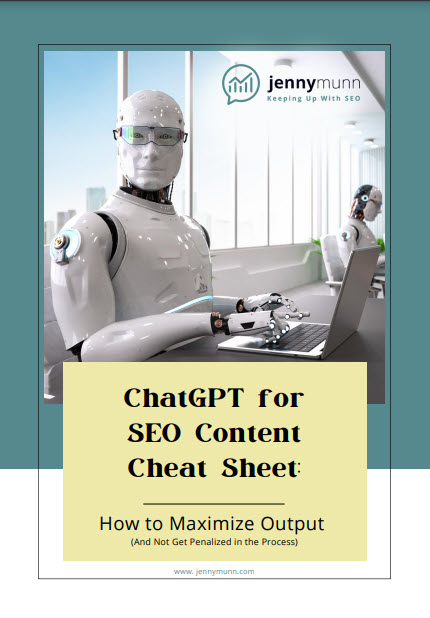A few weeks ago, I shared insight about how to be seen by Google as the expert on a topic.
I referenced the 160-page PDF Google uses as a guide to help their Raters know what to look for in both high-quality and low-quality web pages. Well, this document, the Google Quality Raters Guidelines, just updated their guidelines for the first time in about a year.
One of my pet peeves is the “just create great content” myth perpetuated by certain SEO experts. And thus, there are a lot of questions about what exactly that means.
Per some of the examples provided by Google in their Quality Raters Guidelines, I thought I would show you what they say constitutes both high-quality and low-quality content. Personally, I think the examples shown look like websites straight out of the 00’s. But I suppose that’s irrelevant for their examples.
Here are Google’s guidelines and responses to some of the top questions I hear.
How much content should you write for SEO?
Here are the highlighted passages from the image below:
- The purpose of the page will help you determine what high quality content means for that page.
- The amount of content necessary for the page to be satisfying depends on the topic and purpose fo the page.
- a broad topic with a lot of information will have more content

What is “MC” as referred to in the Google Guidelines above?
MC, as referred to by Google, is “main content.” Google’s example of pages with a satisfying amount of quality MC is below. Notice the sidebar, nor the footer, is considered to be main content.
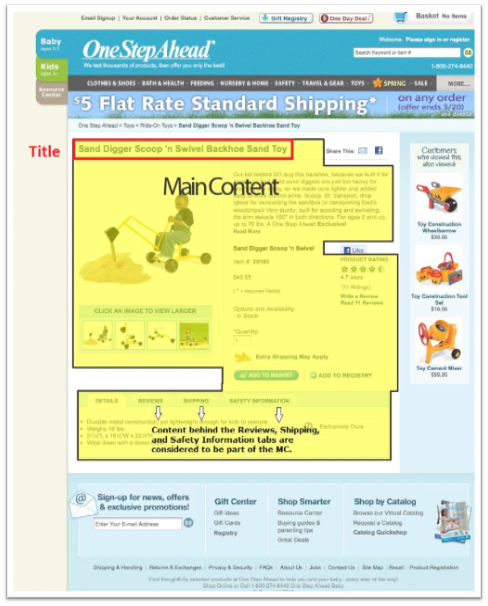
What are the characteristics of High-Quality pages?
What I think is important to note here is Google’s mention of “a satisfying amount” of high-quality MC (main content) is needed. They leave it specifically ambiguous (see above) as to what that means for each page, which is dependent on the intent of the query and the purpose of the page.
Here is the highlighted passage from the image below:
- A satisfying amount of high quality MC, including a descriptive or helpful title
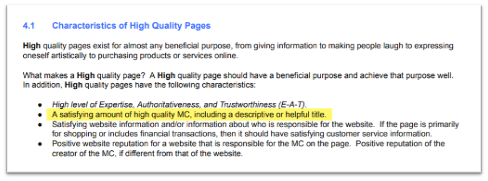
Google’s examples of High-Quality pages
Even though you can’t read the content of the pages in this screenshot (you can zoom in if you go to Google’s Guidelines),you can tell these pages are robust and comprehensive, with elements that Google deems as highly satisfactory for the intent of visitors and purpose of the page.
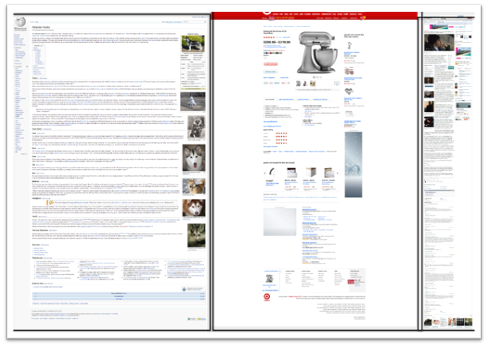
What are the characteristics of Low-Quality pages?
What I think is important, and surprising for many, is the emphasis on the “creator” of the main content. This again goes back to the importance of E-A-T I referenced earlier.
Here are the highlighted passages from the image below:
- they are lacking in an important dimension, such as having an unsatisfying amount of MC, or because the creator of the MC lacks expertise for the purpose of the page
- An inadequate level of Expertise, Authoritativeness, and Trustworthiness (E-A-T)
- The quality of the MC is low
- unsatisfying amount of MC
- title of the MC is exaggerated or shocking
- Ads or SC distracts from the MS
- is an unsatisfying amount of website information or information about the creator
- mildly negative reputation for a website or creator of the MC
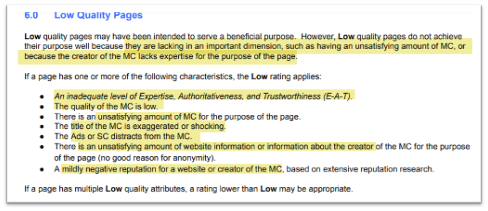
Why does E-A-T matter again?
Here are the highlighted passages from the image below:
- Low quality pages often lack an appropriate level of E-A-T for the purpose of the page
- creator of the MC does not have adequate expertise ini the topic of the MC
- website is not an authoritative source for the topic of the page
- MC is not trustworthy, e.g. a shopping checkout page that has an insecure connection
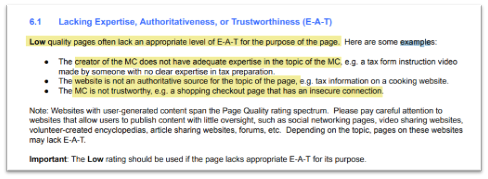
What are examples of Low-Quality pages?
While the design and look and feel of the pages mostly scream low-quality, take a look at the highlighted text in each box below:
Here is the highlighted passage from the image below:
- There is not evidence that the author has financial expertise. Because this is a YMYL financial article, lacking expertise is a reason for a Low rating.
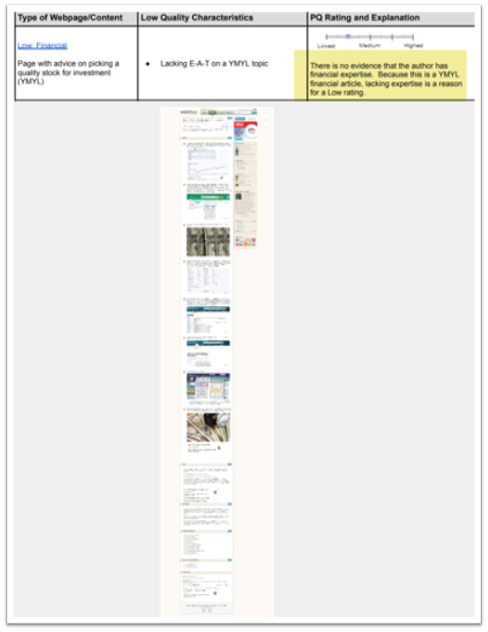
Here are the highlighted passages from the image below:
- This page and website have many characteristics of Low quality pages. The MC is low quality and lacks important information. For example, it gives no indication of how to make a crust and doesn’t list premade crust as an ingredient. It would be very difficult to actually make an apple pie using this recipe.
- This page is lacking the kind of helpful content we expect in recipe pages, such as user reviews or comments. Without such information, it’s hard to tell if the recipe is any good. The small pink text at the top is not helpful for users.
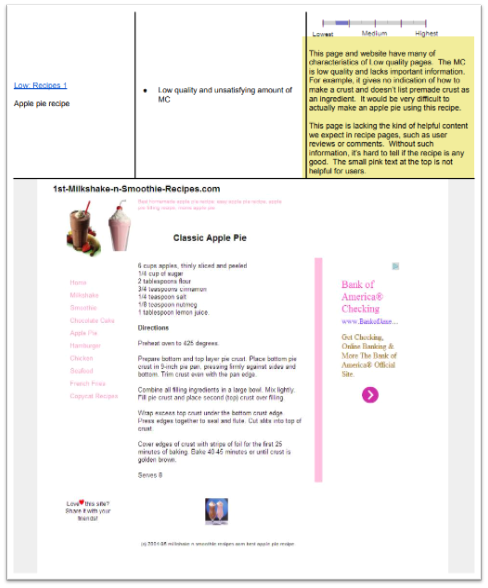
Here is the highlighted passage from the image below:
- This page and website have many characteristics of Low quality pages. Close observation shows MC that contains mostly known information and poor quality writing. The MC is broken up by large Ads that disrupt the user experience.
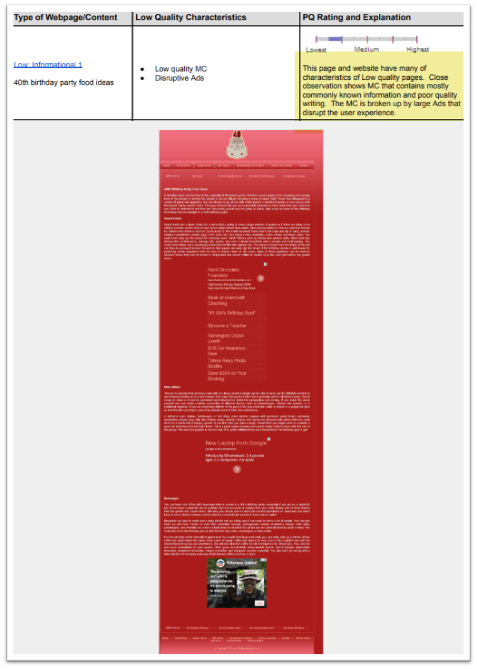
Here are the highlighted passages from the image below:
- The title of the article is misleading and does not reflect the actual content of the pate. The MC does not explain how to get rid of toxins or what the word “toxins” in the headline refers to.
- The content also has many problems: the writing quality is poor, and the article includes meaningless statements such as “water therapy is one of the easiest ways of beauty regimen since it will give enough moisture on the skin”.
- The article fails to cite sources, and there is not evidence of E-A-T.
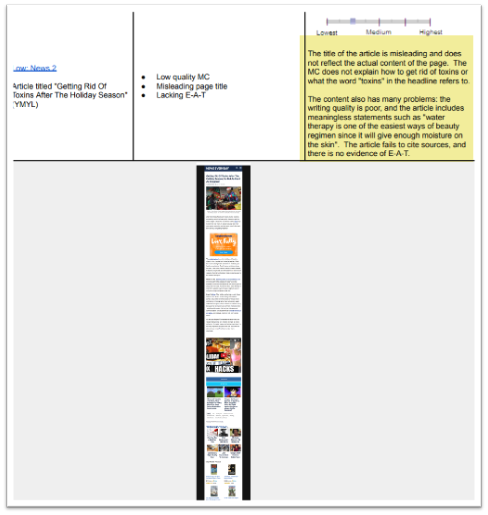
What else matters besides “Great Content”?
And finally, to take us home.
Here are the highlighted passages from the image below:
- Many websites are eager to tell users how great they are.
- But for Page Quality rating, you must also look outside, independent reputation information about the website. When the website says one thing about itself, but reputable external sources disagee with what the website says, trust the external sources.
- Be skeptical of claims that websites make about themselves.

Jenny Munn
Latest posts by Jenny Munn (see all)
- Four 2024 SEO Planning Tips for World Domination - November 16, 2023
- SEO Planning Tip: Why You Need a CYA Clause - November 3, 2023
- How Long Does SEO Take to Show Results? (Updated for 2023) - August 9, 2023

